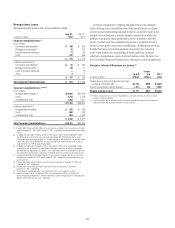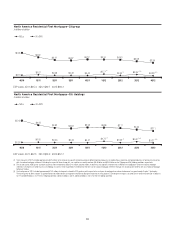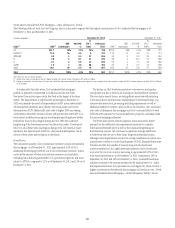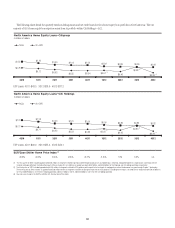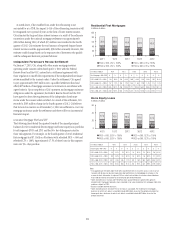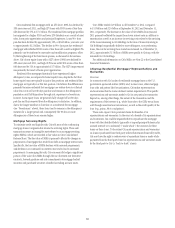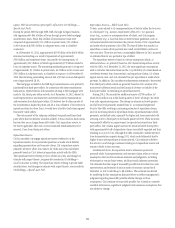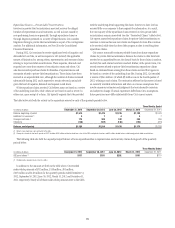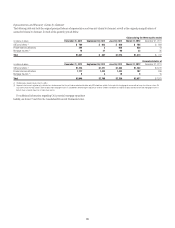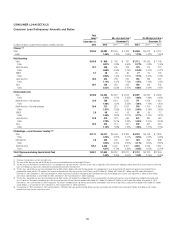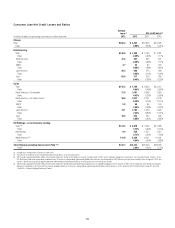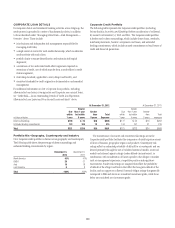Citibank 2012 Annual Report Download - page 112
Download and view the complete annual report
Please find page 112 of the 2012 Citibank annual report below. You can navigate through the pages in the report by either clicking on the pages listed below, or by using the keyword search tool below to find specific information within the annual report.90
Similar to residential first mortgages discussed above, the general
improvement in refreshed CLTV percentages at December 31, 2012 was
primarily the result of improvements in HPI across substantially all
metropolitan statistical areas, thereby increasing values used in the
determination of CLTV. For the reasons described under “North America
Consumer Mortgage Quarterly Credit Trends—Delinquencies and Net
Credit Losses—Home Equity Loans” above, Citi has experienced, and could
continue to experience, increased delinquencies and thus increased net credit
losses in certain of these states and/or regions going forward.
National Mortgage Settlement
Under the national mortgage settlement, entered into by Citi and other
financial institutions in February 2012, Citi is required to provide
(i) customer relief in the form of loan modifications for delinquent
borrowers, including principal reductions, and other loss mitigation
activities to be completed over three years, with a required settlement value
of $1.4 billion; and (ii) refinancing concessions to enable current borrowers
whose properties are worth less than the balance of their loans to reduce
their interest rates, also to be completed over three years, with a required
settlement value of $378 million. Citi commenced loan modifications
under the settlement, including principal reductions, in March 2012 and
commenced the refinancing process in June 2012.
If Citi does not provide the required amount of financial relief in the form
of loan modifications and other loss mitigation activities for delinquent
borrowers or refinancing concessions under the national mortgage
settlement, Citi will be required to make cash payments. Citi is required to
complete 75% of its required relief by March 1, 2014. Failure to meet 100%
of the commitment by March 1, 2015 will result in Citi paying an amount
equal to 125% of the shortfall. Failure to meet the two-year commitment
noted above and then failure to meet the three-year commitment will result
in an amount equal to 140% of the three-year shortfall. Citi continues to
believe that its obligations will be fully met in the form of financial relief to
homeowners; no cash payments are currently expected.
Loan Modifications/Loss Mitigation for Delinquent Borrowers
All of the loan modifications for delinquent borrowers receiving relief
toward the $1.4 billion in settlement value are either currently accounted
for as TDRs or will become TDRs at the time of modification. The loan
modifications have been, and will continue to be, primarily performed
under the HAMP and Citi’s CSM loan modification programs (see Note 16
to the Consolidated Financial Statements). The loss mitigation activities
include short sales for residential first mortgages and home equity loans,
extinguishments and other loss mitigation activities. Based on the nature of
the loss mitigation activities (e.g., short sales and extinguishments), these
activities have not impacted, nor are they expected to have an incremental
impact on, Citi’s TDRs.
Through December 31, 2012, Citi has assisted approximately 34,000
customers under the loan-modification and other loss-mitigation activities
provisions of the national mortgage settlement, resulting in an aggregate
principal reduction of approximately $2.4 billion that is potentially eligible
for inclusion in the settlement value. Net credit losses of approximately
$500 million have been incurred to date relating to the loan modifications
under the national mortgage settlement, all of which were offset by loan
loss reserve releases (including approximately $370 million of incremental
charge-offs related to anticipated forgiveness of principal in connection
with the national mortgage settlement in the first quarter). Citi currently
anticipates an impact to net credit losses associated with the national
mortgage settlement to continue into the first half of 2013. Citi continues to
believe that its loan loss reserves as of December 31, 2012 are sufficient to
cover the required customer relief to delinquent borrowers under the national
mortgage settlement.
Like other financial institutions party to the national mortgage
settlement, Citi does not receive dollar-for-dollar settlement value for the
relief it provides under the national mortgage settlement in all cases. As
a result, Citi anticipates that the relief provided will be higher than the
settlement value.
Refinancing Concessions for Current Borrowers
The refinancing concessions are to be offered to residential first mortgage
borrowers whose properties are worth less than the value of their loans, who
have been current in the prior 12 months, who have not had a modification,
bankruptcy or foreclosure proceeding during the prior 24 months, and whose
loans have a current interest rate greater than 5.25%. As of December 31,
2012, Citi has provided refinance concessions under the national mortgage
settlement to approximately 13,000 customers holding loans with a total
unpaid principal balance of $2.3 billion, thus reducing their interest rate to
5.25% for the remaining life of the loan.
Citi accounts for the refinancing concessions under the settlement
based on whether the particular borrower is determined to be experiencing
financial difficulty based on certain underwriting criteria. When a
refinancing concession is granted to a borrower who is experiencing
financial difficulty, the loan is accounted for as a TDR. Otherwise, the impact
of the refinancing concessions is recognized over a period of years in the
form of lower interest income. As of December 31, 2012, approximately
5,000 customers holding loans with a total unpaid principal balance of
$741 million and who were provided refinance concessions have been
accounted for as TDRs. These refinancing concessions have not had a
material impact on the fair value of the modified mortgage loans.



